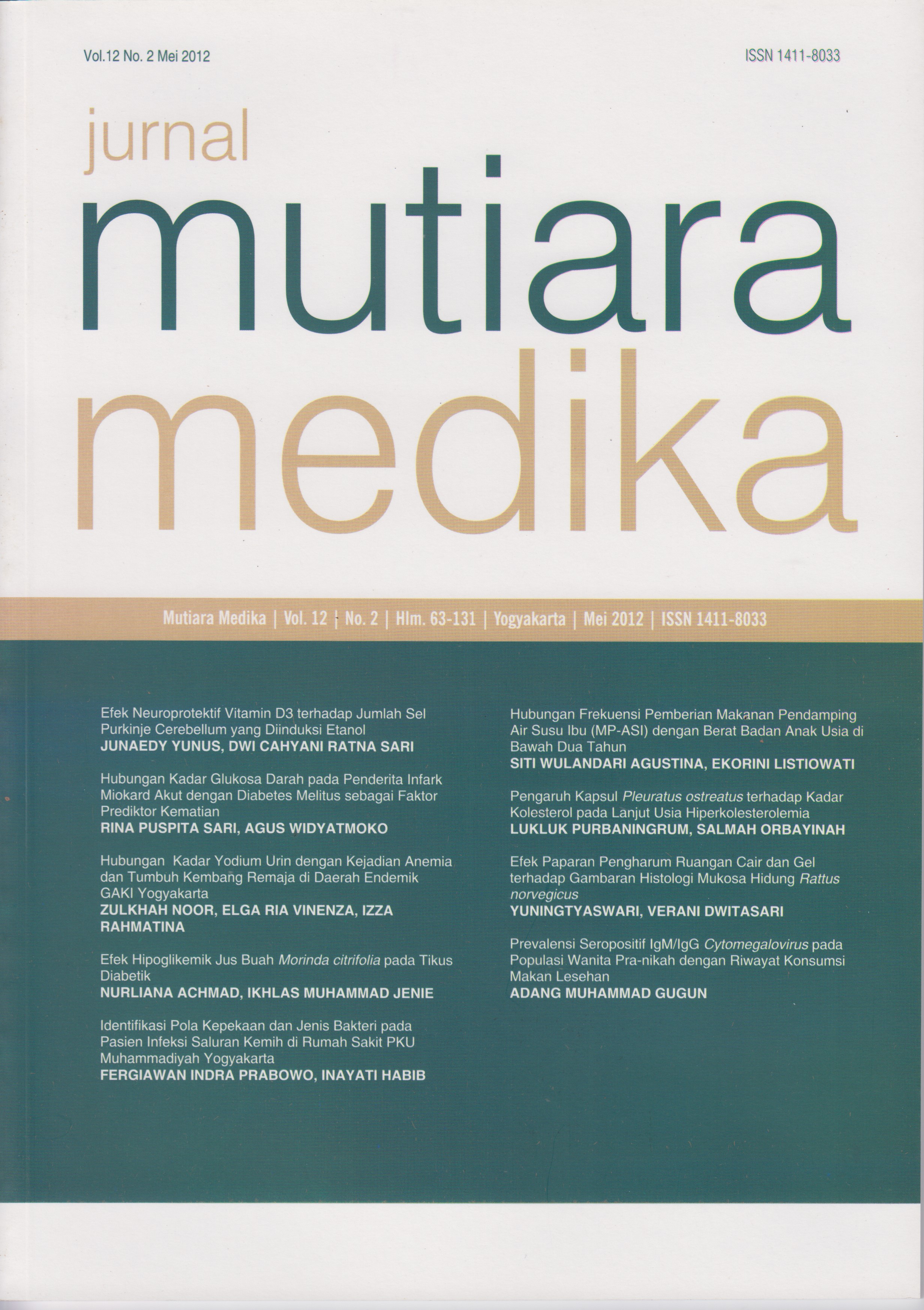Prevalensi Seropositif IgM/IgG Cytomegalovirus pada Populasi Wanita Pra-nikah dengan Riwayat Konsumsi Makan Lesehan
DOI:
https://doi.org/10.18196/mmjkk.v12i2.1024Keywords:
pe-marital women, eating street food consumption, Cytomegalovirus ( CMV), wanita pra-nikah, konsumsi makan lesehanAbstract
Infeksi Cytomegalovirus ( CMV) dapat menyebabkan abortus pada ibu hamil, pertumbuhan janin terhambat, cacat bawaan serta membawa permasalahan infertilitas. Transmisi CMV dapat terjadi melalui kontak langsung atau tidak langsung, kontak seksual, transfusi darah, transplantasi organ atau hal–hal yang berhubungan dengan riwayat kontak erat dengan sekret, saliva dan urin. Makan di warung lesehan semakin banyak diminati oleh orang dewasa muda. Pencucian alat makan yang kurang bersih bisa menularkan infeksi CMV. Oleh karena itu, hubungan antara riwayat konsumsi makan lesehan dengan prevalensi CMV pada wanita pra-nikah perlu diteliti. Desain penelitian ini adalah observasional analitik dengan pendekatan cross sectional, untuk mencari hubungan antara prevalensi seropositif IgM/IgG CMV pada wanita pra-nikah di Kabupaten Bantul dengan riwayat konsumsi makan lesehan. Subyek penelitian berjumlah 90, seluruh subyek mengisi kuesioner dan diambil serumnya kemudian dites ELISA untuk mengetahui keberadaan IgM/IgG anti CMV dalam serum. Data dianalisis dengan uji chi-square. Hasil penelitian menunjukkan 72 dari 90 subyek (80%) positif terinfeksi CMV. Empat puluh dua subyek penelitian yang memiliki faktor risiko riwayat konsumsi makan lesehan, didapatkan sebanyak 33 subyek (78.57%) positif terinfeksi CMV. Hasil uji chi-square menunjukkan p>0.05; Risiko Prevalensi sebesar 0.967; (IK; 95% : 0.785-1.191). Disimpulkan bahwa tidak terdapat hubungan antara faktor risiko riwayat konsumsi makan lesehan terhadap prevalensi seropositif IgM/IgG CMV pada populasi wanita pra-nikah.
Cytomegalovirus (CMV) infection can cause abortion in pregnant women, Intra Uterine Growth Retardation (IUGR), congenital defects and bring the issue of infertility. CMV transmission can occur through direct or indirect contact, sexual contact, blood transfusions, organ transplantation or other matters relating to the history of close contact with secret, saliva and urine. Eating at stalls street food demand by a growing number of young adults. but keep in mind hygiene. Washing eating utensils that are less clean can transmit CMV infection. Therefore, the relationship between a history of consumption street food with the prevalence of CMV infection on premarital women need to be investigated. The study design was observational analytic with cross sectional, to find the relationship between the prevalence of seropositive IgM/IgG CMV in premarital women in Bantul district with a history of eating street food consumption. Research subjects numbered 90, all subjects were asked to fill out questionnaires and retrieved for later in the test serum by ELISA method to determine the presence of IgM/IgG anti-CMV in the serum. The data analysis with chisquare test. The result showed that: Seventy two of all subjects (80%) infected with CMV positive. Fourty two subjects who have risk factor history of consumption lesehan food, obtained a total of 33 subjects (78.57%) infected with CMV positive. Chi-Square test results showed no correlation between risk factor history of eating street food consumption with the prevalence of seropositive IgM/IgG CMV in pre-marital women population (p> 0.05; PR 0.967; 95% CI 0.785-1.191).
References
Suromo, M.A.L Budipradigdo. Kewaspadaan terhadap Infeksi Cytomegalovirus serta Kegunaan Deteksi secara Laboratorik. Semarang: Badan Penerbit Universitas Diponegoro. 2007.
Joseph SA, Beliveau C, Muecke CJ, Rahme E, Soto JC, et al. Risk Faktor for Cytomegalovirus Seropositivity in a Population of Day Care educators in Montreal, Canada. Oxford Journal, 2005; 55: 564-567.
Mulyono, B. Hasil Pemeriksaan Seroimunologi TORCH pada Wanita Infertil, Berkala Ilmu Kedokteran, 1998; 30 (1).
Dwindra, M. Infeksi Sitomegalovirus. Karya Tulis Ilmiah strata satu, Riau: Universitas Riau. 2009.
Chandra, B. Pengantar Kesehatan Lingkungan. Jakarta: Penerbit Buku Kedokteran EGC. 2007.
Purnawijayanti, H.A. Sanitasi Higiene dan Keselamatan Kerja dalam Pengolahan Makanan. Yogyakarta: Kanisius. 2001.
WHO. 10 Facts on Women’s Health. 2011, Maret. Diakses 2 April 2011, dari http://www.who.int/features/factfiles/women/en/index.html
Karkata, K. Infeksi TORCH pada Ibu Hamil di RSUP Sanglah Denpasar. Cermin Dunia Kedokteran, 2006; 151 (151): 5-6.
Mustakangas, P., Sarna, S., Ammala, P., Muttilainen, M., Koskela, P. & Koskiniemi, M. Human Cytomegalovirus Seroprevalence in Three Socioeconomically Differenturban Areas during the First Trimester: a population-based cohort study. Int. J. of Epidemiology, 2000; 29 (3): 588-589.
Stanberry LR, Rosenthal SL, Mills L, Succop PA, Biro FM, et al. Longitudinal Risk of Herpes Simplex Virus (HSV) Type 1, HSV Type 2, and Cytomegalovirus Infections among Young Adolescent Girls. Clin Infect Dis. 2004; 39 (10): 1433-1438.
Fowler, K.B., Pass, R.F. Risk Faktors for Congenital Cytomegalovirus Infection in the Offspring of Young Women: Exposure to Young Children and Recent Onset of Sexual Activity. Pediatrics, 2006; 118 (2): e286-e292.
Downloads
Published
Issue
Section
License
Copyright
Authors retain copyright and grant Mutiara Medika: Jurnal Kedokteran dan Kesehatan (MMJKK) the right of first publication with the work simultaneously licensed under an Attribution 4.0 International (CC BY 4.0) that allows others to remix, adapt and build upon the work with an acknowledgment of the work's authorship and of the initial publication in Mutiara Medika: Jurnal Kedokteran dan Kesehatan (MMJKK).
Authors are permitted to copy and redistribute the journal's published version of the work (e.g., post it to an institutional repository or publish it in a book), with an acknowledgment of its initial publication in Mutiara Medika: Jurnal Kedokteran dan Kesehatan (MMJKK).
License
Articles published in the Mutiara Medika: Jurnal Kedokteran dan Kesehatan (MMJKK) are licensed under an Attribution 4.0 International (CC BY 4.0) license. You are free to:
- Share — copy and redistribute the material in any medium or format.
- Adapt — remix, transform, and build upon the material for any purpose, even commercially.
This license is acceptable for Free Cultural Works. The licensor cannot revoke these freedoms as long as you follow the license terms. Under the following terms:
Attribution — You must give appropriate credit, provide a link to the license, and indicate if changes were made. You may do so in any reasonable manner, but not in any way that suggests the licensor endorses you or your use.
- No additional restrictions — You may not apply legal terms or technological measures that legally restrict others from doing anything the license permits.



